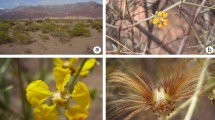Abstract
Gynoecium development in taxa of the tribeVanguerieae (Rubiaceae, subfam.Antirheoideae) was studied, using primarily a 2- and a 5-carpellate genus (Keetia andVangueria) as examples. All investigated taxa, characterized by ovaries with a solitary, ± apically inserted, pendulous anatropous ovule per locule/carpel, showed a very similar gynoecium development. Comparisons with other uniovulateRubiaceae (taxa of subfam.Rubioideae) revealed that notwithstanding the place of insertion and orientation of the solitary ovules (apically vs. basally inserted, pendulous vs. erect, anatropous ovules) the gynoecium development follows the same pattern; differing ovule insertion and orientation can easily be explained by the principle of variable proportions. — Since secondary pollen presentation is characteristic for the tribe, particular attention was paid to the development of the conspicuous “stylar head”-complex, defined here as structural unit comprised of pollen presenting organ, “receptaculum pollinis”, plus stigmatic (i.e., receptive) surfaces. It was found that their morphological differentiation, following the same pattern in all investigated taxa, starts at very early stages of floral development. They already had their final shape at a stage when the ovule development in the ovary had just barely started. The fully developed, actual “receptaculum pollinis” is made up of enormously enlarged, ± cylindrical epidermis cells which have peculiar ring-like thickenings in vicinity of and parallel to the outer tangential walls (a “mechanical barrier” preventing pollen tubes from entering?) and a much smaller-celled subepidermal tissue. With regard to shape, size, and exposure of the stigmatic surfaces, the investigated taxa exhibited certain morphological differences. These were found to be correlated with differences in androecium structure (and, ultimately, pollen presentation).
Similar content being viewed by others
References
Bremekamp, C. E. B., 1929: A revision of the South African species ofPavetta. — Ann. Transvaal Mus.13: 182–213.
, 1966: Remarks on the position, the delimitation and the subdivision of theRubiaceae. — Acta Bot. Neerl.15: 1–33.
Bridson, D. M., 1985: The reinstatement ofPsydrax (Rubiaceae, subfam.Cinchonoideae, tribeVanguerieae) and a revision of the African species. — Kew Bull.40: 687–725.
, 1986: The reinstatement of the African genusKeetia (Rubiaceae, subfam.Cinchonoideae, tribeVanguerieae). — Kew Bull.41: 965–994.
, 1987: Studies in AfricanRubiaceae-Vanguerieae: a new circumscription ofPyrostria and a new subgenus,Canthium subgen.Bullockia. — Kew Bull.42: 611–639.
, 1992: The genusCanthium (Rubiaceae-Vanguerieae) in tropical Africa. — Kew Bull.47: 353–401.
Burck, M. W., 1884: Sur l'organisation florale chez quelques Rubiacées [suite]. — Ann. Jard. Bot. Buitenzorg4: 12–87.
Cavaco, A., 1967:Pyrostria pseudocommersonii etPseudopeponidium antsalovense (Rubiaceae-Vanguerieae) espèces nouvelles de Madagascar. — Adansonia, sér. 2,7: 39–42.
, 1969: Contribution a l'étude des genresPseudopeponidium etPeponidium (Rubiacées-Vanguériées). — Adansonia, sér. 2,9: 43–46.
, 1970:Leroya, nouveau genre deRubiaceae. — Adansonia, sér. 2,10: 333–337.
, 1971a:Neoleroya, nouveau genre deRubiaceae-Vanguerieae. — Adansonia, sér. 2,11: 119–123.
, 1971b: Remarques sur quelquesPyrostria (Rubiacées-Vanguériées) de Madagascar. — Adansonia, sér. 2,11: 393–396.
, 1973: A new species ofLeroya (Rubiaceae-Vanguerieae) from Madagascar. — Kew Bull.28: 349–350.
Gerstenberger, P., Leins, P., 1978: Rasterelektronenmikroskopische Untersuchungen an Blütenknospen vonPhysalis philadelphica (Solanaceae). Anwendung einer neuen Präparationsmethode. — Ber. Deutsch. Bot. Ges.91: 381–387.
Hartl, D., 1962: Die morphologische Natur und die Verbreitung des Apicalseptums. Analyse einer bisher unbekannten Gestaltungsmöglichkeit des Gynoeceums. — Beitr. Biol. Pfl.37: 241–330.
Igersheim, A., 1989: Beiträge zur Klärung der Gattungsabgrenzungsprobleme innerhalb derRubiaceae-Vanguerieae. — Dissertation, University of Vienna.
- 1993: The character states of the Caribbean monotypic endemicStrumpfia (Rubiaceae). — Nordic J. Bot.13 (in press).
Leinfellner, W., 1941: Über den unterständigen Fruchtknoten und einige Bemerkungen über den Bauplan des verwachsenblättrigen Gynoeceums an sich. — Bot. Archiv42: 1–43.
Leins, P., Erbar, C., 1990: On the mechanisms of secondary pollen presentation in theCampanulales-Asterales-complex. — Bot. Acta103: 87–92.
Maheswari Devi, H., Krishnam Raju, P. V. S. N. G., 1978: Embryology ofRubiaceae — 1.Vanguerieae. — J. Indian Bot. Soc.57 [Suppl]: 39.
Nilsson, L. A., Rabakonandrianina, E., Petterson, B., Ranaivo, J., 1990: “Ixoroid” secondary pollen presentation and pollination by small moths in the Malagasy treeletIxora platythyrsa (Rubiaceae). — Pl. Syst. Evol.170: 161–175.
Puff, C., Igersheim, A., Rohrhofer, U., 1993:Pseudomussaenda andSchizomussaenda (Rubiaceae): close allies ofMussaenda. — Bull. Jard. Bot. Nat. Belg.62 (in press).
, 1984: Observations on the SE African-Madagascan genusAlberta and its allyNematostylis (Rubiaceae, Alberteae), with a survey of the species and a discussion of the taxonomic position. — Bull. Jard. Bot. Nat. Belg.54: 293–366.
Robbrecht, E., 1988: Tropical woodyRubiaceae. — Opera Bot. Belg.1: 1–271.
, 1986: A survey of theGardenieae and related tribes (Rubiaceae). — Bot. Jahrb. Syst.108: 63–137.
-Rohrhofer, U., Puff, C., 1993: A survey ofBertiera (Rubiaceae), including a discussion of its taxonomic position. — InRobbrecht, E., (Ed.): Advances inRubiaceae macrosystematics. — Opera Bot. Belg. (in press).
Robyns, W., 1928: Tentamen monographiaeVangueriae generumque affinum. — Bull. Jard. Bot. Etat Brux.11: 1–359.
Silberbauer-Gottsberger, I., 1972: Anthese und Bestäubung der RubiaceenTocoyena brasiliensis undT. formosa aus dem Cerrado Brasiliens. — Österr. Bot. Z.120: 1–12.
, 1975: Über sphingophile Angiospermen Brasiliens. — Pl. Syst. Evol.123: 157–184.
Skottsberg, C., 1945: The flower ofCanthium. — Ark. Bot.32 A(5): 1–12.
Svoma, E., 1991: The development of the bicarpellate gynoecium ofPaederia L. species (Rubiaceae-Paederieae). — InPuff, C., (Ed.): The genusPaederia L. (Rubiaceae-Paederieae): a multidisciplinary study. — Opera Bot. Belg.3. 77–86.
Verdcourt, B., 1983: Notes on MascareneRubiaceae. — Kew Bull.37: 521–574.
, 1987: Notes on AfricanRubiaceae-Vanguerieae. — Kew Bull.42: 123–199.
, 1989:Scyphochlamys revoluta. — Kew Mag.6: 102–106.
, 1991:Rubiaceae (part 3). — InPolhill, R. M., (Ed.): Flora of Tropical East Africa, pp. 749–956. — Rotterdam, Brookfield: Balkema.
Vogel, S., 1954: Blütenbiologische Typen als Elemente der Sippengliederung dargestellt anhand der Flora Südafrikas. — InTroll, W., Guttenberg, H., (Eds): Botanische Studien 1. — Jena: Fischer.
White, F., 1962: Forest flora of Northern Rhodesia. — Oxford: Oxford University Press.
Author information
Authors and Affiliations
Rights and permissions
About this article
Cite this article
Igersheim, A. Gynoecium development inRubiaceae-Vanguerieae, with particular reference to the “stylar head”-complex and secondary pollen presentation. Pl Syst Evol 187, 175–190 (1993). https://doi.org/10.1007/BF00994098
Received:
Accepted:
Issue Date:
DOI: https://doi.org/10.1007/BF00994098




